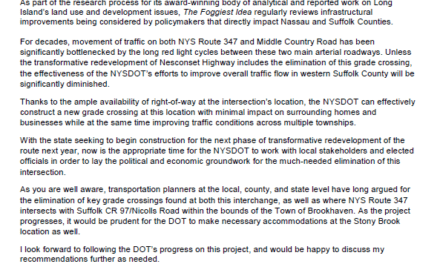The following is a variation of a piece that was written for the May 2018 print edition of Long Island Pulse. You can read the version that appeared in Pulse here.
As the sun rises over the tree line, the bits of light able to make their way through the branches reflect off the gleaming steel of the LIRR tracks. The morning air is chilled as commuters bundle together waiting to catch their next ride west. Many who are waiting on the platform drove to the station, while others came from just a short walk away. This scene plays out across the Island each morning, repeated in reverse each night.
Most standing there drove to the station. For a lucky few, the were able to take a quick walk to the platform.
With average prices for homes and rents for apartments inching north year-by-year across Long Island, the value of these properties is often driven by a multitude of factors, including their proximity to public transit. The question is, does this intangible value translate to dollars and cents in the region’s residential home market? Some experts think so.
“There clearly is a premium for [short] commuting distance outside of the city,” said Jonathan Miller, president and CEO of Manhattan-based Miller Samuel Inc., a real estate appraisal and consulting firm that produces Douglas Elliman’s reports. “Time spent equals value. The ‘Long Island suburb price premium’ is clearly delineated by proximity to the train line versus time of commute.”
Miller should know. For the past two years, his firm calculated the cost-per-minute figure along the Metro-North’s New Haven and Harlem lines for The New York Times. “The delineation of adjustments may change over time as more people telecommute and therefore require fewer trips into the city for their jobs,” Miller added.
According to data cultivated by Suffolk County from 2008 to 2012, planners found that over 103,000 residents commute by rail. Of this total ridership, just over 70,000 hail from Nassau while 33,000 come from out east in Suffolk. These figures, when paired with census data sets complied by The Washington Post, paint a clear picture of who is taking the train to get to work – The numbers amount to 12% of commuters in Suffolk and 23% of commuters in Nassau using one of the LIRR’s 124 train stations to get to work.
As the LIRR struggles to take control of its destiny thanks to everything from acts of God (like successive Nor’easters stopping service), perennially late trains that run on crumbling infrastructure and continuously raising costs, the pressure is on to deliver service that isn’t only more frequent, but reliable. In January 2018 the railroad ran on schedule only about 84 percent of the time—the worst performance in 22 years, and down 7 percent from January 2017. For the entirety of 2017, the LIRR ran on-time just over 91 percent. Compare these relatively dismal figures to 2009, when the railroad hit modern peak of 95.9%. In recent months, longtime commuters have vented their frustrations to Newsday as ridership grows and the pressures on the system mount.
Yet, as the housing market continues to feel pressure due to dwindling supply, accessibility to Manhattan is still an asset some buyers prize – and will continue to as long as there are worthwhile job opportunities west of the Cross Island Parkway.
“It all depends what town you are in and its proximity [to Manhattan],” said James Haydon, a salesperson with Signature Premier in Smithtown. He added that sometimes being too close isn’t always a good thing. “If you’re right next to the tracks then it’s not a value-added incentive because of the noise and vibration.” Haydon echoed the sentiment that the perfect pedigree is a location that is close enough for a quick walk, but far enough to be out of sight, out of mind.
Melissa Gomez, an Associate Real Estate Broker with ERA Top Service Realty, Inc. and secretary of the Long Island Board of Realtors, said that other factors help to drive prices. “While [accessibility to transit] definitely is a consideration, buyers are also looking at quality of schools and the other amenities a community can offer.”, As part of her service, Gomez helps those from out of the area become familiar with the nuances of Long Island’s communities.
Still, other experts found that access to Manhattan isn’t as critical to buyers as policy wonks might think. According to census figures, the overwhelming majority of Suffolk County residents work within the county and many use their cars to commute. In Nassau, where train service is more frequent, ridership to and from Manhattan is a bit higher, but not by much—most still use their cars to commute.
Ann Conroy, president of the Long Island division of Douglas Elliman, believes access is only one piece of the puzzle needed to draw in buyers. “I do not believe you can broad stroke across the Island. Certain areas have benefitted by proximity to transportation if it is part of an active downtown that has great shops and restaurants.” In Conroy’s experience, every buyer has different expectations. “The buyer of today—whether the millennial or the baby boomer—enjoys proximity to thriving downtowns and easy access to the railroad stations.”
It would seem that on Long Island, the phrase “it takes a village” takes on a whole meaning, especially if that particular village has an easy commute to and from Manhattan, as well as a vibrant community fabric that newcomers can join. But Conroy believes the latter has more concrete impact on buyers. “I do not believe that easy access alone impacts pricing. Easy access to a village does.”
While MTA has noted in 2016 that the LIRR is seeing commuter ridership declining, off-peak ridership has blossomed over the last 30 years or so – a trend that is likely to continue as service is likely to improve thanks to large capital projects on the horizon like the third track, which will add additional capacity between Floral Park and Hicksville, or East Side Access, which would bring the rail road into Grand Central Terminal. Further down the road, electrification in eastern Suffolk County will likely bring more commuters west.
The trick will be whether or not the railroad is able to provide stable service to justify taking the quick walk to the station on those chilly dew-soaked mornings.
Richard Murdocco is an award-winning columnist and adjunct professor in Stony Brook University’s public policy graduate program. He regularly writes and speaks about Long Island’s real estate development issues. More of his views can be found on thefoggiestidea.org or follow him on Twitter @thefoggiestidea.












